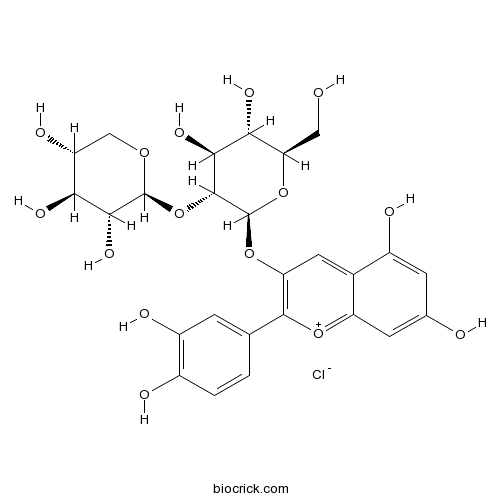An anthocyanidin 3-O-β-D-sambubioside having cyanidin as the anthocyanidin component.
InChI=1S/C26H28O15.ClH/c27-7-18-20(34)21(35)24(41-25-22(36)19(33)15(32)8-37-25)26(40-18)39-17-6-11-13(30)4-10(28)5-16(11)38-23(17)9-1-2-12(29)14(31)3-9;/h1-6,15,18-22,24-27,32-36H,7-8H2,(H3-,28,29,30,31);1H/t15-,18-,19+,20-,21+,22-,24-,25+,26-;/m1./s1
Delphinidin-3-O-sambubioside and cyanidin-3-O-sambubioside are the main anthocyanins of Hibiscus sabdariffa calyces, traditionally used to make a bright red beverage by decoction in water, at natural pH, these anthocyanins are mainly in their flavylium form (red) in equilibrium with the quinonoid base (purple) and the hemiketal (colorless). [1]
Cyanidin-3-O-sambubioside significantly decreases the secretion of matrix metalloproteinase-9 and inhibited matrix metalloproteinase-9 expression, exerts an inhibitory effect on Akt phosphorylation, suggests that it inhibits metastasis processes, such as angiogenesis and invasion, in breast cancer cells through regulation of matrix metalloproteinase-9 activity.[2]
Cyanidin-3-O-sambubioside chloride has antioxidant properties.[3]
English website: Cyanidin-3-O-sambubioside chloride
Japanese website: Cyanidin-3-O-sambubioside chloride
Chinese website: Cyanidin-3-O-sambubioside chloride
[1] Vidot K, Achir N, Christian Mertz, et al. J Agr Food Chem, 2016,.64(20):4139-45.
[2] Lee S J, Hong S, Yoo S H, et al. Planta Med, 2013, 79(17):1636-40.
[3] SalazarGonzález, Vergarabalderas C, Ortegaregules F T, et al. Cienc Inv Agr,,2012, 39(1):79-90.
[4] Jr T A, Chang C, Edirisinghe I, et al. J Agr Food Chem, 2012, 60(23):5803-12.



